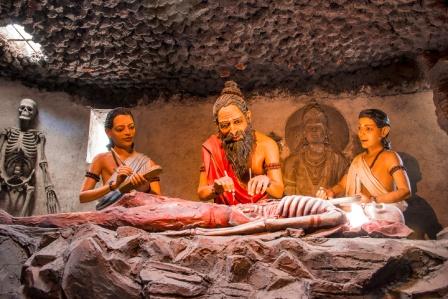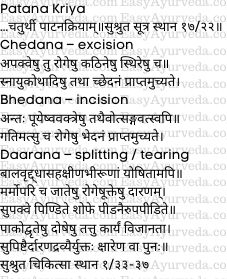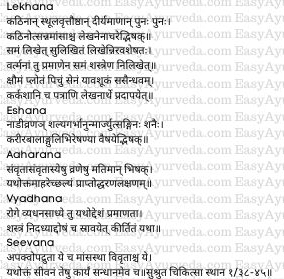Patana Kriya Meaning, Types, Clinical Significance
By Dr Raghuram Y.S. MD (Ay) & Dr Manasa, B.A.M.S
Patana is the fourth type of treatment mentioned amongst ‘Sapta Upakrama’ i.e. the 7 types of treatments. These 7 treatments mentioned by Master Sushruta are not only meant to treat and heal the wounds, ulcers and related swelling but also to prevent their complications.
Read – Sushruta’s 7 Types of Treatments Sapta Upakrama

Table of Contents
Patana Kriya
“Fourthly patana should be done…!”
Paatan means
- tearing
- slipping
- dividing or
- making incision
Kriya is the method in which this is conducted. Nine treatments from amongst the list of 60 treatments mentioned in shashti upakrama are included under patana kriya. They need to be selectively done as per condition of the wound / ulcer / swelling around the ulcer.
Vimlapana means to soften or cause to wither. This procedure is done to soften the wounds or ulcers. This needs to be implemented first in the treatment of wounds and ulcers. The first 6 treatments amongst the Shashti Upakrama are included under vimlapana. These treatments should be skillfully used to make the wounds or ulcers soft. The set of these 6 treatments comprise vimlapana.
Read – Shashti Upakrama Meaning, Classification, Clinical Significance
Sanskrit Verses


Types
Mainly 9 treatments are included under Patana.
| Sl No | Name of the Upakrama (treatment) | Meaning |
| 1 | Chedana | Excision |
| 2 | Bhedana | Incision |
| 3 | Daarana | Splitting |
| 4 | Lekhana | Scraping |
| 5 | Eshana | Probing |
| 6 | Aaharana | Extraction |
| 7 | Vyadhana | Puncturing |
| 8 | Vidravana | Liquefaction |
| 9 | Seevana | Suturing |
If we are following the chronology of the treatments as per shashti upakrama procedures, patana group of treatments should be strictly done after upanaha. If the condition of the wound or swelling available at the time of treating the patient is fit to undergo one of these patana treatments directly, they shall be skillfully chosen.
Read – Kaphaja Upanaha (Netra Roga) – Definition, Symptoms, Treatment
1. Chedana – excision
Conditions in which excision needs to be done –
- Apakveshu tu rogeshu – in the wounds and ulcers which haven’t undergone suppuration
- Kathineshu rogeshu – wounds and ulcers which are hard
- Stihreshu rogeshu – wounds and ulcers which are immobile
- Snayu kothadishu – wounds and ulcers wherein gangrene of the ligaments (tendons, blood vessels etc) have occurred in the surroundings
2. Bhedana – incision
Conditions in which incision needs to be done –
Incision should be done in the wounds and ulcers / swellings wherein –
- Antah puyeshu – there are pus filled pockets
- Avaktreshu – there is no opening (for the drainage of the pus) around the ulcers
- Utsangavatsu api – ulcers are elevated and hollow
- Gatimatsu – ulcers are spreading
Read – Excision and Scraping – Chedana And Lekhana Karma In Eye Disorders
3. Daarana – splitting
Conditions in which splitting needs to be done –
- Bala Vrddha Asaha Kshina Bhiru Yoshitam – ulcers manifesting in children, old aged people, those who are intolerant, emaciated, fearful and in women
- Marmopari Jateshu – ulcers and wounds manifested on the vital spots of the body
How ulcers are split ?
a. Pidana – A wise physician who is well versed and has immense experience in dealing with different stages of wounds and ulcers should first conduct pidana karma i.e. compression of wounds and ulcers. This should be done when the swelling around the ulcers are lumped up and the skin around the ulcers has been suppurated.
How to do?
The herbs which are prescribed for pidana should be ground and made into a paste. This paste is applied on and around the opening of the ulcer and allowed to dry. When the paste of medicines dry up it shrinks the skin around the ulcer and imparts pressure on the ulcer. This will enable the accumulation of pus at one place. The powder of barley, wheat and black gram shall be used for this purpose.
b. Darana – After the ulcers and swelling around them have been properly pressed and compressed following the administration of pidana treatment, darana should be done. So pidana is the preparation for darana and when done on the backdrop of pidana, darana yields good results.
The darana should be done using darana dravyas i.e. herbs capable of splitting or tearing the swelling / ulcer or by the use of kshara.
The below mentioned herbs are used for this purpose –
- Chirabilva – Holoptelea integrifolia
- Agni – Semecarpus anacardium
- Danti – Baliospermum montanum
- Chitraka – Plumbago zeylanica
- Hayamaraka – Nerium indicum
- Kapota purisha – feces of pigeon / dove
- Grdhra purisha – feces of vulture
- Kanka purisha – feces of heron
4. Lekhana – scraping
Conditions in which scraping needs to be done –
- Kathina – ulcers which are hard and tough
- Sthula Vrutta oshtan – ulcers which have thick and rounded edges
- Diryamanan punah punah – ulcers which break open repeatedly
- Kathina utsanna mamsa – presence of hard and elevated muscles around the ulcers
How much scraping should be done?
- In the hard and tough wounds and ulcers should be scraped evenly i.e. neither too much nor too less.
- In thick and round edged ulcers scraping should be done in excess.
- In the ulcers that break open repeatedly complete scraping should be done without leaving any portion which needs to be scraped.
- In ulcers having hard and elevated ulcers, the excessive portions should be scraped off using suitable instruments.
In the absence of surgical instruments for scraping, gauze, cotton, cuttlefish, alkali of barley, rock salt or rough leaves are used for the same purpose.
5. Eshana – probing
Conditions in which probing needs to be done –
- Nadivrana – sinus ulcers
- Shalya garbha – ulcers containing foreign substances
- Unmargi vrana – fistula in anal region
- Utsangi vrana – hollow ulcers
Shoot of a bamboo, hairs, fingers and metal probes should be used by the physician gradually and carefully for the purpose of probing.
Read – Fistula In Ano Ayurvedic Understanding And Effective Treatment
6. Aaharana – extraction
A wise physician should extract the foreign body from the wound / ulcer without any part of it remaining within it. It shall be extracted from the closed or open ulcers following the principles of extraction explained in the sutra sthana section. ‘Symptoms of proper extraction’ are the indicators of the foreign body being removed completely.
Nishalya Lakshana – signs / symptoms of proper removal of foreign body from the wound / ulcer
- Alpa badham – less trouble / pain
- Ashunam – lack of numbness
- Nirujam – painless
- Nirupadravam – absence of complications
- Prasannam – looks clear
- Mrdu paryantam – edges are soft / smooth
- Niraghattam – immobile
- Anunnatam – not raised
The ulcer having above said signs should be examined with the help of a probe and also by flexing and extending the part of the body / limb wherein the ulcer consisting of the foreign body is located. Following this the surgeon should declare that the ulcer / wound / swelling are devoid of foreign material.
Read – Sushruta’s 8 Types Of Surgical Procedures – Astavidha Shastra Karma
7 and 8 Vyadhana – puncturing and Vidravana – liquefaction (drain)
Puncturing and draining of ulcers / wounds (accumulation of fluids in the ulcers and swelling surrounding them) are related procedures. First the surgeon punctures the ulcers and then drains them of their content.
Expert surgeon should puncture the ulcer / wound which are eligible to be punctured using suitable instruments. Puncturing is useful in diseases like ascites, abscess and hydrocele. Following puncture the contents like pus etc contained in the ulcer / swelling around the ulcer shall be drained.
9. Seevana – suturing
Conditions in which suturing needs to be done –
- Apaka upadruta – ulcers not associated with complications of suppuration
- Mamsa sthita – ulcers localized (seated) in the muscles
- Vivrta – open ulcers
Read – Injury, Wound care Ayurvedic Remedies, Medicines
Summary
The above mentioned measures of Patana treatment are useful in opening (excision, incision, tearing) the ulcers and swelling around it, to scrap off the unwanted tissues around the ulcers and wounds, to probe the interiors of ulcers and sinuses, to extract the foreign substances impacted inside the ulcers and swellings, to puncture and drain the accumulated fluids like pus and water and for suturing the open wounds and ulcers. All these measures include minor surgical measures which need to be done at proper time seeing the condition of the ulcers. A good expertise and experience is needed by the surgeon to diagnose the condition properly and to administer the treatment as per the need and condition. These procedures are usually done after upanaha (poultice and other related treatments) if chronology is being followed. The 13 procedures included under shodhana (cleansing treatments) and ropana (healing treatments) shall be done after patana procedures.
Click to Consult Dr Raghuram Y.S. MD (Ayu)









